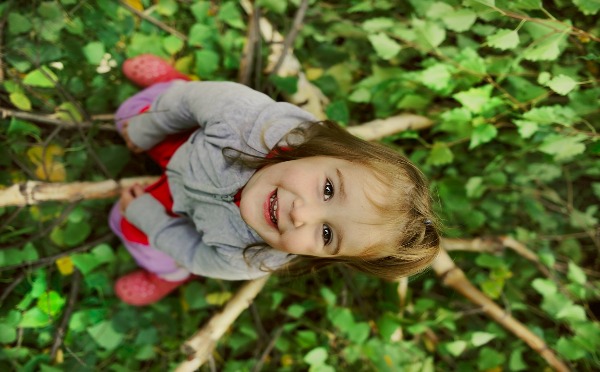As parents in today’s world we are inundated with possibilities for our children. Music lessons, sports, chess club, swimming lessons and the list goes on and on. Extracurricular activities have become a major part of parenting and childhood. I just watched a woman on a popular morning news show talk about tips for picking the right activities for children. I was not surprised that she completely left off the most important activity for children- not even a mention. With our current race to get our children involved in the most promising activities, we have forgotten the one activity that can enrich, teach and heal our children; nature.
A recent two year study out of England showed the dismal relationship our children have with nature. Researchers found that more than 10 percent of children haven’t spent time in any natural setting for at least one year. A natural setting was described as a park, forest, beach, or other natural environment. (1) Nature has so much to offer our children and we need to prioritize it.
Nature Is Filled With Health Promoting Microbes
First of all, being immersed in nature allows children to come into contact with a variety of microbes that benefit their health and development. Our gut microbiome has a dramatic impact on our overall health. Making sure our children have a diverse and healthy population of gut bacteria will go far in supporting the health and development of our little ones. One of the best ways to do this is to allow your child to be introduced to the trillion+ microbes that reside in the soil. Microbes found in nature have been shown to act as natural anti-depressants and even powerful antibiotics. (2,3) Even opening the windows and getting fresh air inside can help expose little ones to more diverse gut bacteria. (4) Their developing immune systems need this introduction to nurture a robust and diverse population of gut bacteria.
Is Nature Good For The Brain?
In Japan and Sweden forest schools are becoming more popular. Forest schools are outside based schools where children spend a significant time outside, rain or shine. This time outside has been shown to improve children’s mental and physical health including their concentration, cognitive and executive function. (5) Forest baths are also becoming more popular with people of all ages. Initial research out of Tokyo found that forest baths, time in nature ranging from a day to 2-3 days, can increase NK cells which boosts the body’s immune system responsible for fighting infections and cancer. (5) Recent research has shown that forest bathing can decrease blood pressure, heart rate, sympathetic nerve activity as well as lower anxiety and depression. (6)
Time in nature has been shown to improve healing and outcomes in hospitals, improve cognitive/executive function in children playing in natural settings, and to decrease pain and anxiety in adults as well as lower cortisol and inflammatory levels in the body. (7,8) Microbes in the dirt have been found to activate neurons in the brain to produce serotonin, the feel good neurotransmitter. (9) It has even been shown to increase feelings of empathy and love. People shown nature images had the areas of the brain that are responsible for empathy and love light up. (10)
Our Connection With Nature
It is clear that there is a much deeper connection here at play than just the gut microbiome. We need to honor that connection and make sure our children are out in nature daily. It doesn’t have to be hard. Having the kids play outside daily, going deeper into nature as a family once a weekend, even bringing more plants into our home all have a big impact on our health and the health of our children. If there is one truly must-do activity for your children have it be time spent in nature.
– Dr. Catherine Clinton
(1) https://www.childrenandnature.org/2016/02/18/study-reveals-too-many-children-in-england-are-losing-contact-with-nature/
(2) Matthews DM, Jenks SM. Ingestion of Mycobacterium vaccae decreases anxiety-related behavior and improves learning in mice. Behav Processes. 2013 Jun;96:27-35.
(3) Losee L. Ling, Tanja Schneider, Aaron J. Peoples, Amy L. Spoering, Ina Engels, Brian P. Conlon, Anna Mueller, Till F. Schäberle, Dallas E. Hughes, Slava Epstein, Michael Jones, Linos Lazarides, Victoria A. Steadman, Douglas R. Cohen, Cintia R. Felix, K. Ashley Fetterman, William P. Millett, Anthony G. Nitti, Ashley M. Zullo, Chao Chen, Kim Lewis. A new antibiotic kills pathogens without detectable resistance. Nature 517,455–459,22 January 2015
(4) http://www.ncbi.nlm.nih.gov/pubmed/22278670
(5) http://www.ncbi.nlm.nih.gov/pmc/articles/PMC2793341/
(6) http://www.ncbi.nlm.nih.gov/pubmed/24858507
(7) http://www.sciencedirect.com/science/article/pii/S2212041614001648?np=y
(8) Park, S., & Mattson, R. (2009). Ornamental indoor plants in hospital rooms enhanced health outcomes of patients recovering from surgery. Journal of Alternative & Complementary Medicine, 15(9), 975-980.
(9) Lowry CA, et al., Identification of an immune-responsive mesolimbocortical serotonergic system: Potential role in regulation of emotional behavior, Neuroscience (2007), doi: 10.1016/j.neuroscience.2007.01.067
(10) Weinstein, N. (2009). Can nature make us more caring? Effects of immersion in nature on intrinsic aspirations and generosity. Personality and Social Psychology Bulletin, 35, 1315.
